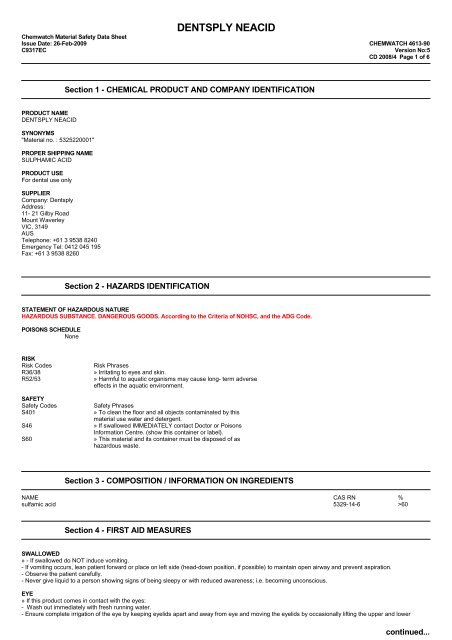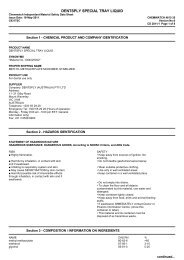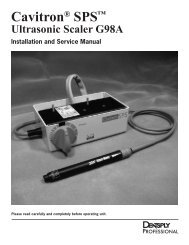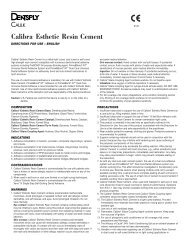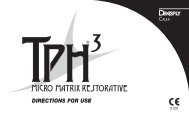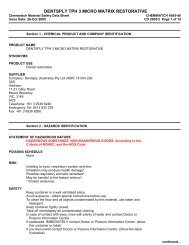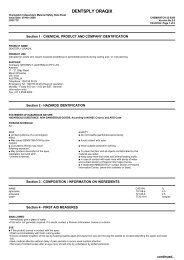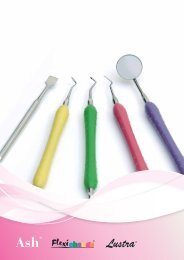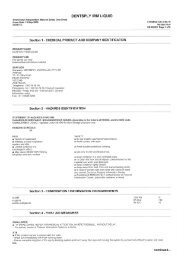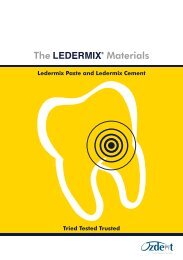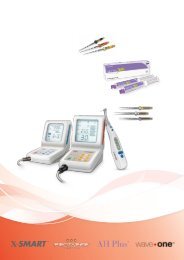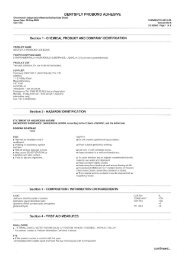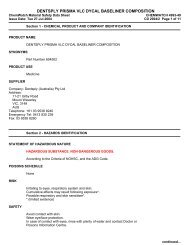Chemwatch Australian MSDS 4613-90 Dentsply Neacid
Chemwatch Australian MSDS 4613-90 Dentsply Neacid
Chemwatch Australian MSDS 4613-90 Dentsply Neacid
You also want an ePaper? Increase the reach of your titles
YUMPU automatically turns print PDFs into web optimized ePapers that Google loves.
DENTSPLY NEACID<br />
<strong>Chemwatch</strong> Material Safety Data Sheet<br />
Issue Date: 26-Feb-2009 CHEMWATCH <strong>4613</strong>-<strong>90</strong><br />
C9317EC<br />
Version No:5<br />
CD 2008/4 Page 1 of 6<br />
Section 1 - CHEMICAL PRODUCT AND COMPANY IDENTIFICATION<br />
PRODUCT NAME<br />
DENTSPLY NEACID<br />
SYNONYMS<br />
"Material no. : 5325220001"<br />
PROPER SHIPPING NAME<br />
SULPHAMIC ACID<br />
PRODUCT USE<br />
For dental use only<br />
SUPPLIER<br />
Company: <strong>Dentsply</strong><br />
Address:<br />
11- 21 Gilby Road<br />
Mount Waverley<br />
VIC, 3149<br />
AUS<br />
Telephone: +61 3 9538 8240<br />
Emergency Tel: 0412 045 195<br />
Fax: +61 3 9538 8260<br />
Section 2 - HAZARDS IDENTIFICATION<br />
STATEMENT OF HAZARDOUS NATURE<br />
HAZARDOUS SUBSTANCE. DANGEROUS GOODS. According to the Criteria of NOHSC, and the ADG Code.<br />
POISONS SCHEDULE<br />
None<br />
RISK<br />
Risk Codes<br />
Risk Phrases<br />
R36/38 » Irritating to eyes and skin.<br />
R52/53 » Harmful to aquatic organisms may cause long- term adverse<br />
effects in the aquatic environment.<br />
SAFETY<br />
Safety Codes<br />
S401<br />
S46<br />
S60<br />
Safety Phrases<br />
» To clean the floor and all objects contaminated by this<br />
material use water and detergent.<br />
» If swallowed IMMEDIATELY contact Doctor or Poisons<br />
Information Centre. (show this container or label).<br />
» This material and its container must be disposed of as<br />
hazardous waste.<br />
Section 3 - COMPOSITION / INFORMATION ON INGREDIENTS<br />
NAME CAS RN %<br />
sulfamic acid 5329-14-6 >60<br />
Section 4 - FIRST AID MEASURES<br />
SWALLOWED<br />
» - If swallowed do NOT induce vomiting.<br />
- If vomiting occurs, lean patient forward or place on left side (head-down position, if possible) to maintain open airway and prevent aspiration.<br />
- Observe the patient carefully.<br />
- Never give liquid to a person showing signs of being sleepy or with reduced awareness; i.e. becoming unconscious.<br />
EYE<br />
» If this product comes in contact with the eyes:<br />
- Wash out immediately with fresh running water.<br />
- Ensure complete irrigation of the eye by keeping eyelids apart and away from eye and moving the eyelids by occasionally lifting the upper and lower<br />
continued...
DENTSPLY NEACID<br />
<strong>Chemwatch</strong> Material Safety Data Sheet<br />
Issue Date: 26-Feb-2009 CHEMWATCH <strong>4613</strong>-<strong>90</strong><br />
C9317EC<br />
Version No:5<br />
CD 2008/4 Page 2 of 6<br />
Section 4 - FIRST AID MEASURES<br />
lids.<br />
- If pain persists or recurs seek medical attention.<br />
- Removal of contact lenses after an eye injury should only be undertaken by skilled personnel.<br />
SKIN<br />
» If skin contact occurs:<br />
- Immediately remove all contaminated clothing, including footwear.<br />
- Flush skin and hair with running water (and soap if available).<br />
- Seek medical attention in event of irritation.<br />
INHALED<br />
» - If dust is inhaled, remove from contaminated area.<br />
- Encourage patient to blow nose to ensure clear passage of breathing.<br />
- If irritation or discomfort persists seek medical attention.<br />
NOTES TO PHYSICIAN<br />
» Treat symptomatically.<br />
For acute or short term repeated exposures to strong acids:<br />
- Airway problems may arise from laryngeal edema and inhalation exposure. Treat with 100% oxygen initially.<br />
- Respiratory distress may require cricothyroidotomy if endotracheal intubation is contraindicated by excessive swelling<br />
- Intravenous lines should be established immediately in all cases where there is evidence of circulatory compromise.<br />
- Strong acids produce a coagulation necrosis characterised by formation of a coagulum (eschar) as a result of the dessicating action of the acid on<br />
proteins in specific tissues.<br />
Section 5 - FIRE FIGHTING MEASURES<br />
EXTINGUISHING MEDIA<br />
» - Water spray or fog.<br />
- Foam.<br />
- Dry chemical powder.<br />
- BCF (where regulations permit).<br />
FIRE FIGHTING<br />
» - Alert Fire Brigade and tell them location and nature of hazard.<br />
- Wear full body protective clothing with breathing apparatus.<br />
- Prevent, by any means available, spillage from entering drains or water course.<br />
- Use fire fighting procedures suitable for surrounding area.<br />
When any large container (including road and rail tankers) is involved in a fire,<br />
consider evacuation by 800 metres in all directions.<br />
FIRE/EXPLOSION HAZARD<br />
» - Non combustible.<br />
- Not considered to be a significant fire risk.<br />
- Acids may react with metals to produce hydrogen, a highly flammable and explosive gas.<br />
- Heating may cause expansion or decomposition leading to violent rupture of containers.<br />
Decomposition may produce toxic fumes of: ammonia, nitrogen oxides (NOx), sulfur oxides (SOx).<br />
FIRE INCOMPATIBILITY<br />
» None known.<br />
HAZCHEM: 2X<br />
Personal Protective Equipment<br />
Gas tight chemical resistant suit.<br />
Section 6 - ACCIDENTAL RELEASE MEASURES<br />
EMERGENCY PROCEDURES<br />
MINOR SPILLS<br />
» - Drains for storage or use areas should have retention basins for pH adjustments and dilution of spills before discharge or disposal of material.<br />
- Check regularly for spills and leaks.<br />
- Clean up all spills immediately.<br />
- Avoid contact with skin and eyes.<br />
- Wear protective clothing, gloves, safety glasses and dust respirator.<br />
- Use dry clean up procedures and avoid generating dust.<br />
MAJOR SPILLS<br />
» - Clear area of personnel and move upwind.<br />
- Alert Fire Brigade and tell them location and nature of hazard.<br />
- Wear full body protective clothing with breathing apparatus.<br />
- Prevent, by any means available, spillage from entering drains or water course.<br />
Personal Protective Equipment advice is contained in Section 8 of the <strong>MSDS</strong>.<br />
continued...
DENTSPLY NEACID<br />
<strong>Chemwatch</strong> Material Safety Data Sheet<br />
Issue Date: 26-Feb-2009 CHEMWATCH <strong>4613</strong>-<strong>90</strong><br />
C9317EC<br />
Version No:5<br />
CD 2008/4 Page 3 of 6<br />
Section 7 - HANDLING AND STORAGE<br />
PROCEDURE FOR HANDLING<br />
» - Avoid all personal contact, including inhalation.<br />
- Wear protective clothing when risk of exposure occurs.<br />
- Use in a well-ventilated area.<br />
- Avoid contact with moisture.<br />
SUITABLE CONTAINER<br />
» - DO NOT use aluminium or galvanised containers.<br />
- Glass container is suitable for laboratory quantities.<br />
- Lined metal can, lined metal pail/ can.<br />
- Plastic pail.<br />
- Polyliner drum.<br />
- Packing as recommended by manufacturer.<br />
STORAGE INCOMPATIBILITY<br />
» - Inorganic acids are generally soluble in water with the release of hydrogen ions. The resulting solutions have pH's of less than 7.0.<br />
- Inorganic acids neutralise chemical bases (for example: amines and inorganic hydroxides) to form salts - neutralisation can generate dangerously<br />
large amounts of heat in small spaces.<br />
- The dissolution of inorganic acids in water or the dilution of their concentrated solutions with additional water may generate significant heat.<br />
- The addition of water to inorganic acids often generates sufficient heat in the small region of mixing to cause some of the water to boil<br />
explosively. The resulting "bumping" can spatter the acid.<br />
Avoid contamination / mixing with oxidising agents as ignition may result.<br />
- Avoid strong bases.<br />
Avoid halogens<br />
STORAGE REQUIREMENTS<br />
» - Store in original containers.<br />
- Keep containers securely sealed.<br />
- Store in a cool, dry, well-ventilated area.<br />
- Store away from incompatible materials and foodstuff containers.<br />
Section 8 - EXPOSURE CONTROLS / PERSONAL PROTECTION<br />
EXPOSURE CONTROLS<br />
The following materials had no OELs on our records<br />
• sulfamic acid: CAS:5329- 14- 6<br />
PERSONAL PROTECTION<br />
RESPIRATOR<br />
Particulate<br />
EYE<br />
» - Safety glasses with side shields.<br />
- Chemical goggles.<br />
- Contact lenses may pose a special hazard; soft contact lenses may absorb and concentrate irritants. A written policy document, describing the<br />
wearing of lens or restrictions on use, should be created for each workplace or task. This should include a review of lens absorption and adsorption<br />
for the class of chemicals in use and an account of injury experience. Medical and first-aid personnel should be trained in their removal and<br />
suitable equipment should be readily available. In the event of chemical exposure, begin eye irrigation immediately and remove contact lens as soon<br />
as practicable. Lens should be removed at the first signs of eye redness or irritation - lens should be removed in a clean environment only after<br />
workers have washed hands thoroughly. [CDC NIOSH Current Intelligence Bulletin 59].<br />
HANDS/FEET<br />
» - Wear chemical protective gloves, eg. PVC.<br />
- Wear safety footwear or safety gumboots, eg. Rubber.<br />
Suitability and durability of glove type is dependent on usage. Factors such as:<br />
- frequency and duration of contact,<br />
- chemical resistance of glove material,<br />
- glove thickness and<br />
- dexterity,<br />
OTHER<br />
» - Overalls.<br />
- PVC Apron.<br />
- PVC protective suit may be required if exposure severe.<br />
- Eyewash unit.<br />
» - Respirators may be necessary when engineering and administrative controls do not adequately prevent exposures.<br />
- The decision to use respiratory protection should be based on professional judgment that takes into account toxicity information, exposure<br />
measurement data, and frequency and likelihood of the worker's exposure - ensure users are not subject to high thermal loads which may result in heat<br />
stress or distress due to personal protective equipment (powered, positive flow, full face apparatus may be an option).<br />
- Published occupational exposure limits, where they exist, will assist in determining the adequacy of the selected respiratory . These may be<br />
continued...
DENTSPLY NEACID<br />
<strong>Chemwatch</strong> Material Safety Data Sheet<br />
Issue Date: 26-Feb-2009 CHEMWATCH <strong>4613</strong>-<strong>90</strong><br />
C9317EC<br />
Version No:5<br />
CD 2008/4 Page 4 of 6<br />
Section 8 - EXPOSURE CONTROLS / PERSONAL PROTECTION<br />
government mandated or vendor recommended.<br />
- Certified respirators will be useful for protecting workers from inhalation of particulates when properly selected and fit tested as part of a<br />
complete respiratory protection program.<br />
ENGINEERING CONTROLS<br />
» - Local exhaust ventilation is required where solids are handled as powders or crystals; even when particulates are relatively large, a certain<br />
proportion will be powdered by mutual friction.<br />
- If in spite of local exhaust an adverse concentration of the substance in air could occur, respiratory protection should be considered.<br />
Such protection might consist of:<br />
(a): particle dust respirators, if necessary, combined with an absorption cartridge;<br />
(b): filter respirators with absorption cartridge or canister of the right type;<br />
(c): fresh-air hoods or masks.<br />
Air contaminants generated in the workplace possess varying "escape" velocities which, in turn, determine the "capture velocities" of fresh<br />
circulating air required to effectively remove the contaminant.<br />
Section 9 - PHYSICAL AND CHEMICAL PROPERTIES<br />
APPEARANCE<br />
White powder with a sour odour; mixes with water.<br />
PHYSICAL PROPERTIES<br />
Corrosive.<br />
Acid.<br />
Molecular Weight: Not Applicable<br />
Boiling Range (°C): Not Applicable<br />
Melting Range (°C): Not Available Specific Gravity (water=1): 2.1<br />
Solubility in water (g/L): 278 g/L<br />
pH (as supplied): Not Applicable<br />
pH (1% solution):
DENTSPLY NEACID<br />
<strong>Chemwatch</strong> Material Safety Data Sheet<br />
Issue Date: 26-Feb-2009 CHEMWATCH <strong>4613</strong>-<strong>90</strong><br />
C9317EC<br />
Version No:5<br />
CD 2008/4 Page 5 of 6<br />
Section 11 - TOXICOLOGICAL INFORMATION<br />
Section 12 - ECOLOGICAL INFORMATION<br />
Harmful to aquatic organisms, may cause long-term adverse effects in the aquatic environment.<br />
This material and its container must be disposed of as hazardous waste.<br />
Section 13 - DISPOSAL CONSIDERATIONS<br />
» Recycle wherever possible.<br />
- Consult manufacturer for recycling options or consult local or regional waste management authority for disposal if no suitable treatment or<br />
disposal facility can be identified.<br />
- Treat and neutralise at an approved treatment plant. Treatment should involve: Mixing or slurrying in water; Neutralisation with soda-lime or sodaash<br />
followed by: Burial in a licenced land-fill or Incineration in a licenced apparatus (after admixture with suitable combustible material)<br />
- Decontaminate empty containers with 5% aqueous sodium hydroxide or soda ash, followed by water. Observe all label safeguards until containers are<br />
cleaned and destroyed.<br />
Section 14 - TRANSPORTATION INFORMATION<br />
Labels Required: CORROSIVE<br />
HAZCHEM: 2X (ADG7)<br />
Land Transport UNDG:<br />
Class or division: 8 Subsidiary risk: None<br />
UN No.: 2967 UN packing group: III<br />
Shipping Name:SULPHAMIC ACID<br />
Air Transport IATA:<br />
ICAO/IATA Class: 8 ICAO/IATA Subrisk: None<br />
UN/ID Number: 2967 Packing Group: III<br />
Special provisions:<br />
None<br />
Shipping Name: SULPHAMIC ACID<br />
Maritime Transport IMDG:<br />
IMDG Class: 8 IMDG Subrisk: None<br />
UN Number: 2967 Packing Group: III<br />
EMS Number: F- A, S- B Special provisions: None<br />
Limited Quantities:<br />
5 kg<br />
Shipping Name: SULPHAMIC ACID<br />
Section 15 - REGULATORY INFORMATION<br />
POISONS SCHEDULE: None<br />
REGULATIONS<br />
Regulations for ingredients<br />
<strong>Dentsply</strong> <strong>Neacid</strong> (CAS: None):<br />
No regulations applicable<br />
sulfamic acid (CAS: 5329-14-6) is found on the following regulatory lists;<br />
Australia Hazardous Substances<br />
Australia Inventory of Chemical Substances (AICS)<br />
Australia Standard for the Uniform Scheduling of Drugs and Poisons (SUSDP) - Appendix E (Part 2)<br />
Australia Standard for the Uniform Scheduling of Drugs and Poisons (SUSDP) - Appendix F (Part 3)<br />
Australia Standard for the Uniform Scheduling of Drugs and Poisons (SUSDP) - Schedule 5<br />
Australia Standard for the Uniform Scheduling of Drugs and Poisons (SUSDP) - Schedule 6<br />
International Council of Chemical Associations (ICCA) - High Production Volume List<br />
OECD Representative List of High Production Volume (HPV) Chemicals<br />
continued...
DENTSPLY NEACID<br />
<strong>Chemwatch</strong> Material Safety Data Sheet<br />
Issue Date: 26-Feb-2009 CHEMWATCH <strong>4613</strong>-<strong>90</strong><br />
C9317EC<br />
Version No:5<br />
CD 2008/4 Page 6 of 6<br />
Section 16 - OTHER INFORMATION<br />
» Classification of the preparation and its individual components has drawn on official and authoritative sources as well as independent review by<br />
the <strong>Chemwatch</strong> Classification committee using available literature references.<br />
A list of reference resources used to assist the committee may be found at:<br />
www.chemwatch.net/references.<br />
» The (M)SDS is a Hazard Communication tool and should be used to assist in the Risk Assessment. Many factors determine whether the reported Hazards<br />
are Risks in the workplace or other settings.<br />
This document is copyright. Apart from any fair dealing for the purposes of private study, research, review or<br />
criticism, as permitted under the Copyright Act, no part may be reproduced by any process without written<br />
permission from CHEMWATCH. TEL (+61 3) 9572 4700.<br />
Issue Date: 26-Feb-2009<br />
Print Date: 26-Feb-2009<br />
This is the end of the <strong>MSDS</strong>.


